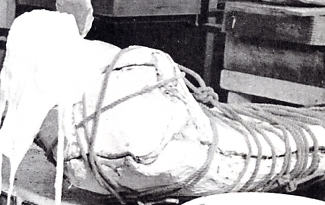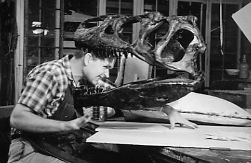|
 |
This is vastly more complicated and should only be attempted by a professional mold maker. Of course, anyone who wants to try it, can do so, but it is so complicated that lack of experience will ensure failure. The reason is that there are actually two molds to be made, the first one is made out of latex to ensure maximum fidelity of the surfaces, the scond of which is made of plaster of paris. The first one is thin and floppy so it must be stabilized by the second - which is not floppy.
Iíve talked about this experiment elsewhere, but again, I didnít focus on the molds so will do that this time. When dad experimented with foam at Harvard in 1957, he used the latex and plaster molds that he had alread yprepared for making plaster casts. In that instance, however, he was ysing foam experimentally to see if it would work, because if it did, it would save an enormous amount of weight.
I couldnít find any photos that really showed the things that need to be showed so Iíll do what I can with what I have. In the first photo above, you see that a bunch of plaster pieces are being tied together. He always used amber surgical tubing because it was easy to use, easy to tie, and as you stretched more and more layers over the thing, the more and more pressure was generated to hold things together. In this image you cas see a long line along the bottom edge of the mold, which turns on the left end and goes along the back side that we canít see. That line is the joint where a large wide flate plaster mold section joins the other section.
 If you look carefully, under his RIGHT hand ABOVE, amongst the tubes and shadows, you can see a sharp point pointing directly at, and adjacent to his right middle finger. The line that extends to downward in both directions outlines a semi-circular mold section that was actually a rough semi-circle. In the image to the RIGHT, you can SEE its shape and see just how irregular it was. (Foam is the stuff flowing out of the spout.) If you read the page about the bee hive, you understand that this funny shaped piece was necessary to get a straight pull of the mold elements when the mold was dissembled. If you look carefully, under his RIGHT hand ABOVE, amongst the tubes and shadows, you can see a sharp point pointing directly at, and adjacent to his right middle finger. The line that extends to downward in both directions outlines a semi-circular mold section that was actually a rough semi-circle. In the image to the RIGHT, you can SEE its shape and see just how irregular it was. (Foam is the stuff flowing out of the spout.) If you read the page about the bee hive, you understand that this funny shaped piece was necessary to get a straight pull of the mold elements when the mold was dissembled.
In the above image, you also see a line that runs from the end of his right thumb across the top of the plaster mold to the far edge, sort of making a banana peel out of the plaster.
Now that you  understand how the OUTSIDE mold works, we can talk about the inner latex mold, the floppy soft one. In this image, you see dad painting Tincture of Green Soap on the white latex mold. The three black surfaces are the holes that appear in the finished skull. understand how the OUTSIDE mold works, we can talk about the inner latex mold, the floppy soft one. In this image, you see dad painting Tincture of Green Soap on the white latex mold. The three black surfaces are the holes that appear in the finished skull.  This image below with dadís head in the mouth shows the holes where the eyes and muscles fitted in life. This image below with dadís head in the mouth shows the holes where the eyes and muscles fitted in life.
In the above photo where heís painting, you see that long flattish plaster mold piece that I pointed out above. The skull in this image is turned inside out. The thickness of the actual foam or plaster is about an inch which is only possible once the latex mold elements are taped together and then secured inside of the plaster mold.
|